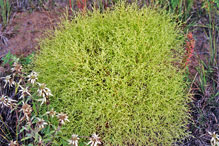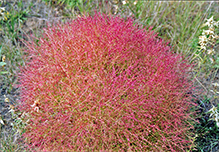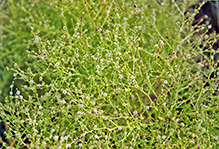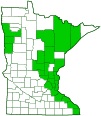winged pigweed
(Dysphania atriplicifolia)
Conservation • Wetland • Description • Habitat • Ecology • Use • Distribution • Taxonomy
Description |
||
Winged pigweed is a 4″ to 32″ tall, densely branched, rounded, annual tumbleweed rising from a big taproot. The stems are up to 2′ long, spreading, and much branched. They are covered with soft, short or long, woolly hairs when young, but become hairless at maturity. All of the terminal branches end in flower spikes. The leaves are alternate, up to 3″ long and ¾″ wide at the base of the stem, getting progressively smaller as they ascend the stem. They are lance shaped, with large, irregular, coarse, wavy but sharp teeth. They are pointed at the tip and taper to the base. They are attached to the stem on short leaf stalks or on no stalk at all. They may be hairy or hairless. They are pale green when young but turn dark purple as the plant matures and soon fall off. The inflorescence is a branched, interrupted, flowering spike at the end of every stem and branch. The branches of the inflorescence spread widely and loosely. The spikes have minute bracts scattered unevenly along their lengths, and from the axils of the bracts a single or a few flowers rise. The flowers are minute, ⅛″ or slightly more wide, greenish, and are attached to the spike without flower stalks. They have no petals. The 5 sepals are fused together from the base and urn-shaped to more than half their length, pointed at their tips. They are green and covered with soft, woolly hairs, but soon become hairless and turn reddish. The fruit is small, a little more than ⅛″ wide, round, thin walled, one-seeded, and bladder–like. It has a distinctive, thin, flat, circular, nearly transparent membrane (wing) extending a little more than ⅛″ from the margin. It is this wing that gives the plant its common name and makes it easy to identify. As the plant matures the leaves fall away. The branches harden, their tips bend inward, and they become brittle. The stems soon separate from the roots close to the ground. At this point the plant is a tumbleweed. It spreads its seeds as it is blown in the wind. |
||
Height |
||
4″ to 32″ |
||
Flower Color |
||
Green, turning reddish |
||
Similar Species |
||
The circular, winged fruit are diagnostic. |
||
Habitat |
||
Dry. Prairies, fields, roadsides, disturbed sites. Full or partial sun. Sandy soil. |
||
Ecology |
||
Flowering |
||
July to August |
||
Pests and Diseases |
||
|
||
Use |
||
|
||
Distribution |
||||
|
Sources |
|||
| 7/23/2023 | ||||
Nativity |
||||
Native |
||||
Occurrence |
||||
|
||||
Taxonomy |
|||
| Kingdom | Plantae (Plants) | ||
| Division | Tracheophyta (Vascular Plants) | ||
| Subdivision | Spermatophytina (Seed Plants) | ||
| Class | Magnoliopsida (Dicots) | ||
Order |
Caryophyllales (Pinks, Cactuses, and Allies) | ||
Family |
Amaranthaceae (amaranths) | ||
| Subfamily | Chenopodioideae (saltbush) | ||
| Tribe | Dysphanieae | ||
Genus |
Dysphania | ||
| Section | Adenois | ||
Winged pigweed was formerly classified as Cycloloma atriplicifolium. The genus Cycloma had been erected to contain just this one species. A recent molecular phylogenetic study of the families Chenopodioideae and Amaranthaceae (Utolia, et al., 2021) showed the Cycloma was nested within Dysphania. The move has been widely but not universally accepted. |
|||
Subordinate Taxa |
|||
|
|||
Synonyms |
|||
Cyclolepis platyphylla Cycloloma atriplicifolium Cycloloma platyphylla Kochia atriplicifolia Salsola atriplicifolia Salsola platyphylla |
|||
Common Names |
|||
tumble ringwing tumbleweed tumbling-ringwing winged pigweed winged-pigweed |
|||
Glossary
Axil
The upper angle where the leaf stalk meets the stem.
Bract
Modified leaf at the base of a flower stalk, flower cluster, or inflorescence.
Wing
A thin, flat membranous, usually transparent, appendage on the margin of a structure.
Visitor Photos |
|||||
Share your photo of this plant. |
|||||
| This button not working for you? Simply email us at info@MinnesotaSeasons.com. Attach one or more photos and, if you like, a caption. |
|||||
|
|||||
MinnesotaSeasons.com Photos |
|||||
 |
 |
||||
 |
|||||

Slideshows |
||

Visitor Videos |
|||
Share your video of this plant. |
|||
| This button not working for you? Simply email us at info@MinnesotaSeasons.com. Attach a video, a YouTube link, or a cloud storage link. |
|||
Other Videos |
|||

Visitor Sightings |
|||||
Report a sighting of this plant. |
|||||
| This button not working for you? Simply email us at info@MinnesotaSeasons.com. Be sure to include a location. |
|||||
|
|||||
MinnesotaSeasons.com Sightings |
|||||

Created 12/26/2011
Last Updated:
